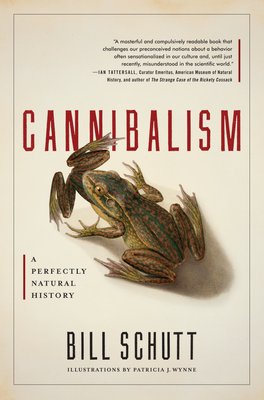
The phrase “I’m having an old friend for dinner” took on a new meaning with the closing words of Hannibal Lecter in the film version of Thomas Harris’s “The Silence of the Lambs.” Dr. Lecter topped the list of screen villains in a poll by the American Film Institute.Cannibalism is a bizarre practice. Eating the flesh of a member of one’s own species is the most horrifying thing one can do. We are simultaneously fascinated with and repelled by it. But it is regarded as a grisly aberration, something that, though horrible, happens rarely.
In Bill Schutt’s new book, “Cannibalism: A Perfectly Natural History” (Algonquin Books, 332 pp. $26.95), we learn that it is not as aberrant as we might think, and it occurs throughout the natural world and in many human societies.
As Mr. Schutt points out: “Far from being the nightmarish aberration we tell ourselves it is—in films, novels and tabloid sensationalism—cannibalism has woven itself into our myths and legends, formed the basis of miracle cures, ancient and modern, helped discipline naughty children (and entertain good ones), popped up in the Bible, fascinated anthropologists, zoologists and biologists and—sadly—played a significant role in colonialism, conquest and war.”
Mr. Schutt, a Hampton Bays resident, is a professor of biology at LIU Post and a research associate in residence at the American Museum of Natural History. He is the author of “Dark Banquet: Blood and the Curious Lives of Blood-Feeding Creatures” (he does have a taste—so to speak—for the gruesome) and co-author of the novel “Hell’s Gate.”
The mammalian population is not exempt from eating its own. Less than half have a nurturing instinct. Among those who don’t, a cub or a pup could be a fast-food lunch.
There are several types of human cannibalism. The most common among humans of the last few centuries is “survival cannibalism.” Examples would be the Donner party in California and the soccer team that was stranded in the Uruguayan Andes.
There are records from World War II in which, in some of the Japanese prison camps, prisoners were tortured and then eaten, Mr. Schutt writes: “Presumably, with their supply routes interrupted by Allied submarines and bombing raids, the Japanese were on such short rations that they resorted to cannibalism.” Several of those involved were later arrested, but since cannibalism was not listed as a war crime, they were convicted instead of not permitting the “honorable burial” of the prisoners who had been eaten.
There is “ritual cannibalism,” in which mourners ate parts of deceased family members as part of the process of grieving. During the early years of the Christian church, non-Christians believed that Christians were practicing this in the Eucharist or Communion—eating Christ’s body and drinking his blood.
When Columbus arrived in the New World, he reported that the indigenous peoples, the Caribs, practiced cannibalism, but Mr. Schutt is dubious. It seemed another reason to kill off the locals. And they died in astonishing numbers. The historian David Stannard, says Mr. Schutt, “believes that by the end of the 16th century, the Spanish had been directly or indirectly responsible for the deaths of between 60 million and 80 million indigenous people in the Caribbean, Mexico and Central America. Even if one were to discount the millions of deaths resulting from diseases, this would still make the Spanish conquest of the New World the greatest act of genocide in recorded history.”
“Ritual cannibalism” was practiced by the Wari’ tribe, who live in the Amazonian rain forests of Brazil. With the arrival of missionaries, the practice reportedly ceased, though doubts remain. The Wari’ believed that burying the dead was barbaric compared to their own non-barbaric dining. They considered the ground “cold, wet and polluting” and that “to leave a loved one’s body to rot in the dirt was disrespectful and degrading to the dead and heart-wrenching for those who mourned them.”
The insect and arachnid population make humans and mammals seem like pikers. Parents eat their offspring, offspring eat their parents, females eat their mates (during copulation). In their excitement, female praying mantises often bite off the heads of their lovers. It’s all just one happy family in the insect world.
As Mr. Schutt says, “the ick factor is high.” That’s at all levels of the evolutionary ladder. When reading “Cannibalism” one might fortify oneself with “fava beans and a nice chianti.” Hannibal Lecter seems almost Franciscan in the midst of all this consumption.